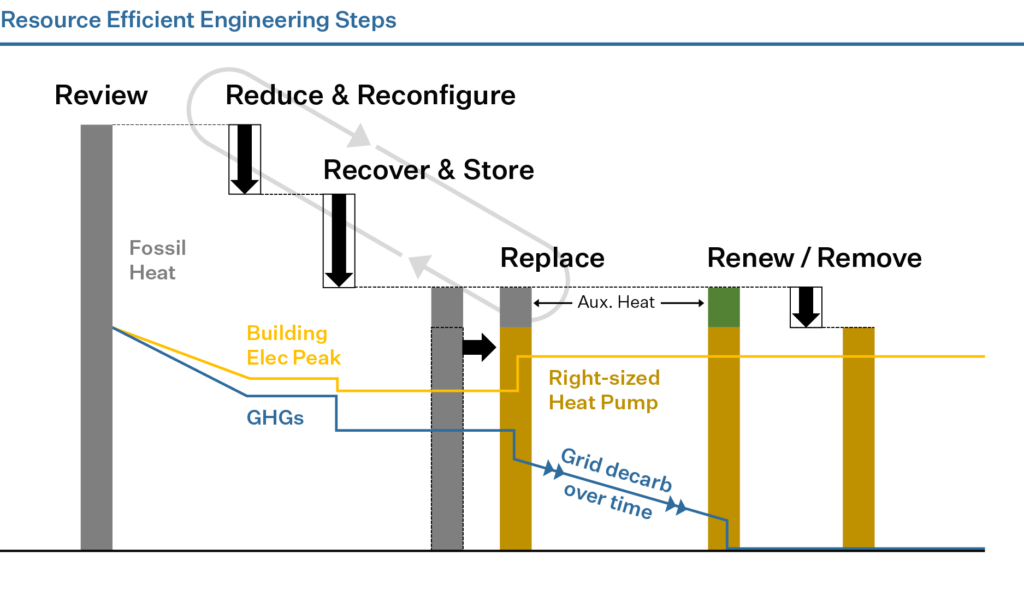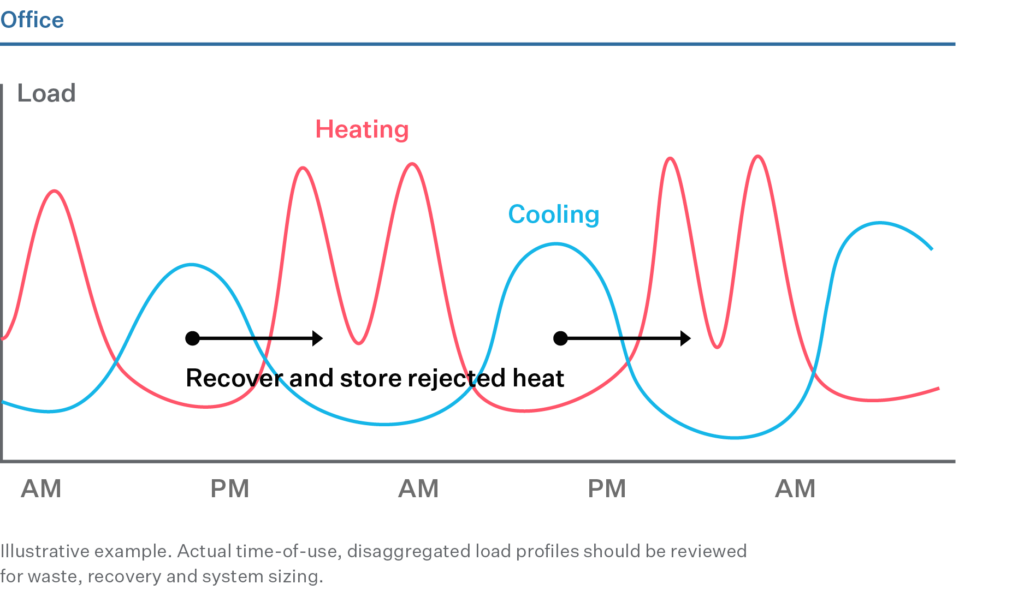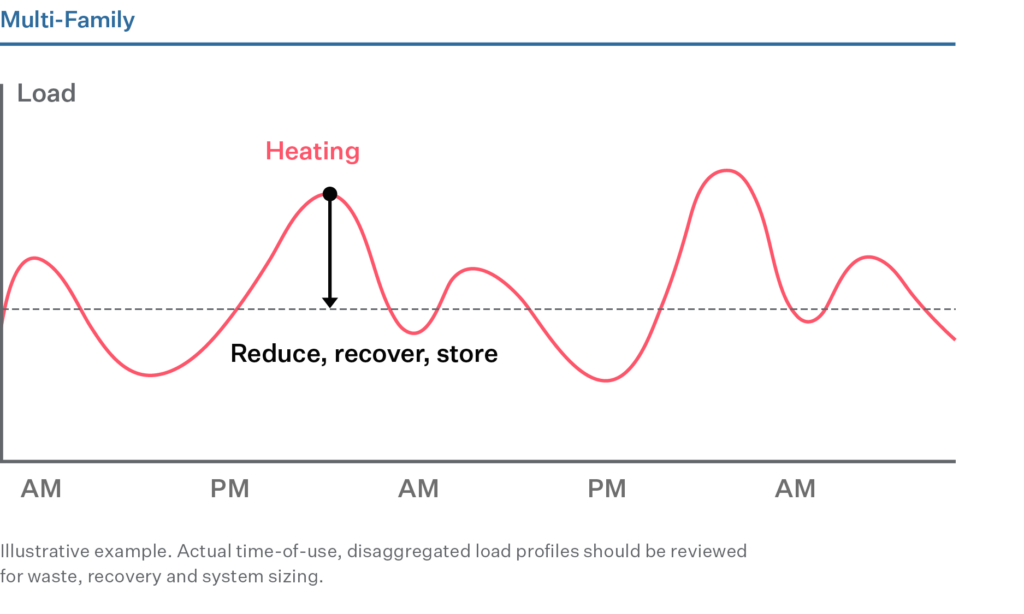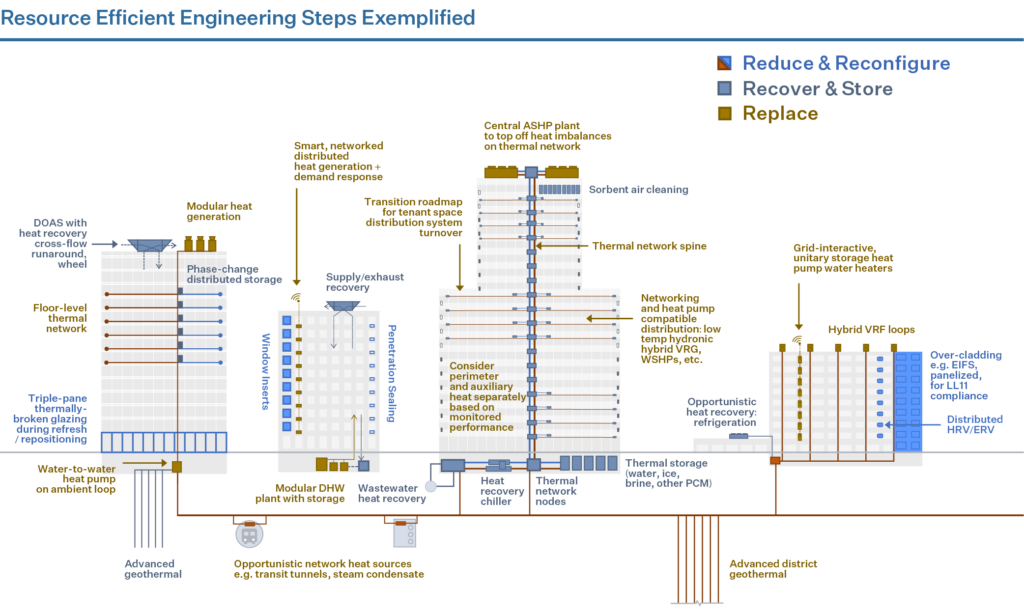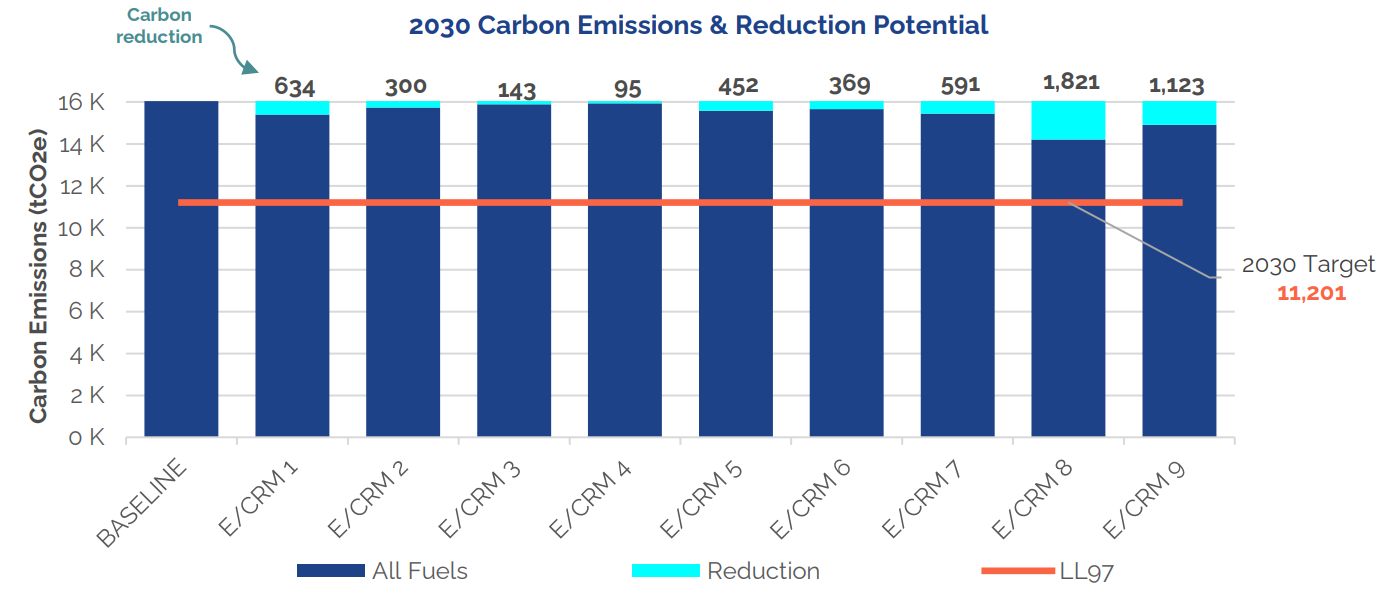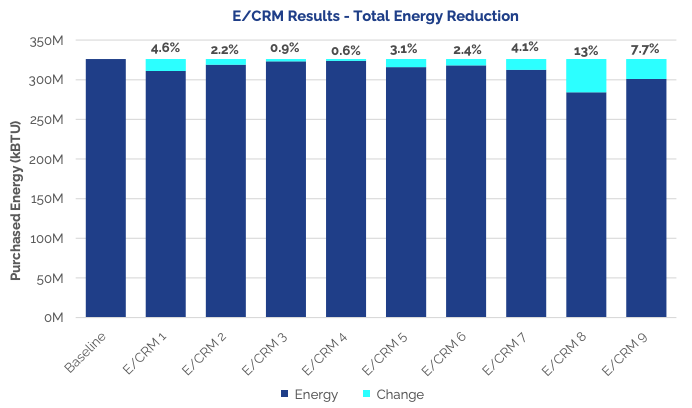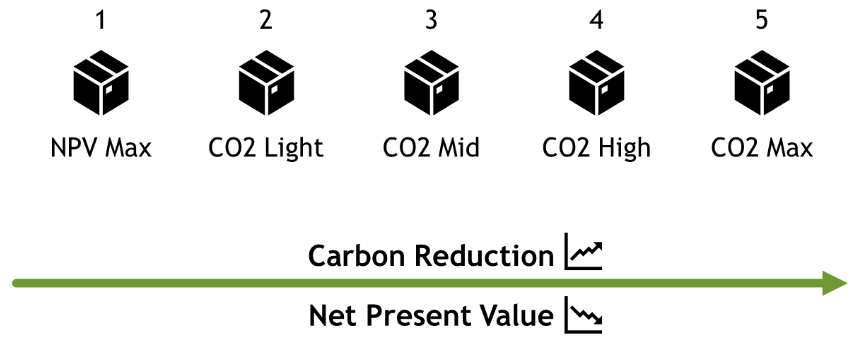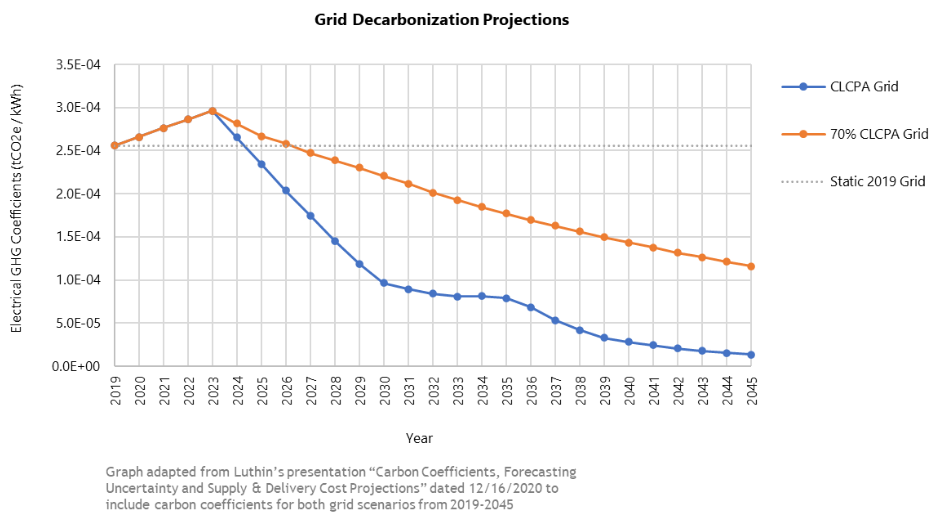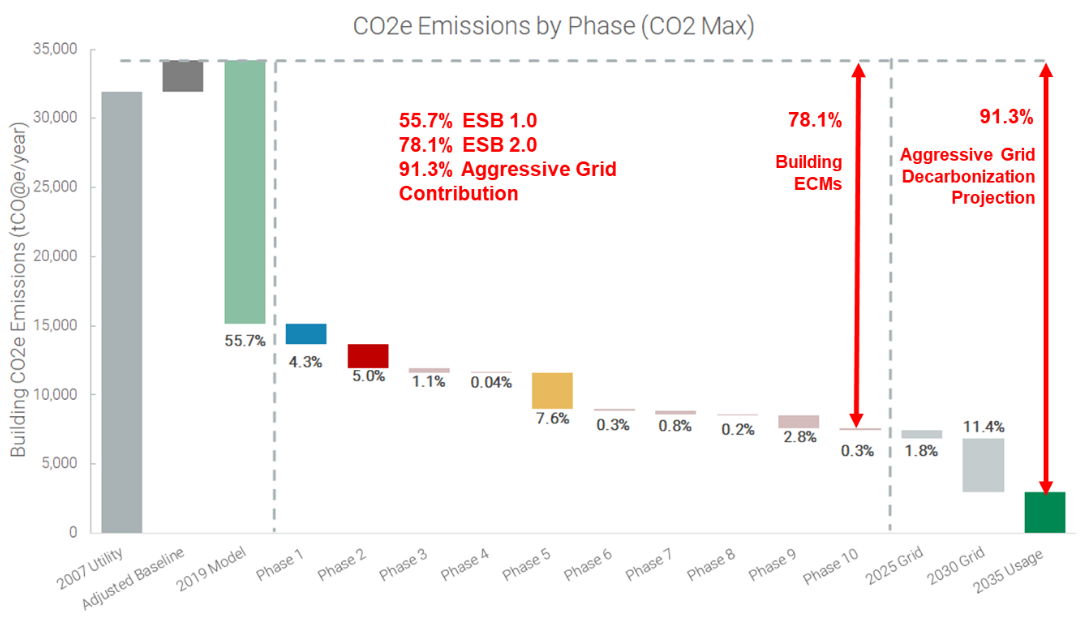Insights from Empire Building Challenge
The discovery phase is intended to provide an initial understanding of the building’s existing conditions, current challenges, and potential opportunities. The data and insights gathered during this phase will be used to create the building’s calibrated energy model. Key activities in this workstream include:
- Collecting and reviewing relevant building information
- Observing building operations under different conditions
- Testing subsystems and their interactions
- Creating the Business-as-Usual (BAU) base case
This workstream is critical because it grounds the project team in the reality of the building’s current performance. It also helps build a jointly owned process for uncovering early energy or carbon reduction opportunities that can increase trust and enthusiasm to identify more complex measures as the project progresses.
At the end of this phase, the team should have a clear understanding of the building energy systems, its historical energy and carbon profile, the potential impact of local laws or other building requirements, opportunities for additional metering, and preliminary energy and carbon reduction opportunities.
This workstream provides vital information on current challenges, near and longer-term carbon reduction opportunities, and the accuracy of the energy model. It also creates early wins that build momentum and trust. Getting the most out of this work requires trust-based collaboration between multiple stakeholders, including facilities managers, operations staff, the energy modeler, external contractors, and design engineers. Engaging with tenants to get insight into what drives their loads can also add value and inform this process. Data and insights on the building’s existing condition typically arise from four sources:
- Design documents
- Data from metered systems
- Direct observation and testing
- Building operations team feedback
Each source is important, but it is the integration across these four categories of data that leads to deep operational insights and identification of major areas of opportunity.
Inputs
- Cross-disciplinary, trust-based collaboration
- Tenant insights
Activities
Gather Information:
In this phase, project teams should work with the building management and operations teams to collect key information using the sample checklist shown below.
| Collected Information | Why is this information needed? |
| Architectural Drawings: · Floor Plans · Elevation Drawings · Vertical Floor Dimensions · Tenant Fit-out Drawings · Façade Cut/Detail Sheets · Window Cut/Detail Sheets | Architectural drawings will be used to build the energy model geometry and assign performance characteristics to exterior wall assemblies. |
| Mechanical, Electrical and Plumbing Drawings: · Mechanical Schedules · Mechanical Riser Diagrams · M-Drawings (Schedules) of Retrofit/Upgraded Equipment or a Description of Changes · Electrical Schedules · Electrical Riser Diagrams · Lighting Schedules and Detail Sheets · Plumbing Schedules · Plumbing Riser Diagrams | MEP drawings will be used to build the energy-consuming systems in the energy model. These documents will also inform opportunities for equipment replacements based on end of useful life and can be referenced when evaluating equipment locations and available space. |
| Utility Data: · Minimum 12 months of data for all incoming utilities including electricity, natural gas, district steam, fuel oil · Data from tenant electrical sub-meters (if available) · Data from central plant BTU meters (if available) | Building utility bills showing annual energy consumption and tariffs are required to create an initial energy model. Utility bills allow the energy modeler to calibrate the total energy consumption and the breakdown by fuel type, which is important to track as different fuel sources have different greenhouse gas emissions and associated energy costs. |
| BMS Operational Information: · Fan run hours · Damper and valve positions · Air and water flow rates · Air handling unit supply air set points · Space temperature set points · Air, water and space temperatures · Chiller/cooling tower/boiler entering and leaving water temperatures · Pump flows during peak and off-peak times · Fan and pump electrical consumption and demand data from VFDs Relevant BMS parameters include: · Meter data · Equipment hours of operation · Temperature setpoints · Data trends · Fault detection · System mode (manual versus override) | Historical data from the BMS can help align modeled energy use breakdowns with actual operation. Collating and reviewing this data can provide insights into building operations. Sometimes building operation differs from the document design, standards, and even the facilities team’s own understanding as system modifications are made incrementally over the years. Live data can be used to verify system schedules, turndown, and setpoints and drive even more accurate modeling of building operations. Building management systems provide insight into how the building is performing in real-time. |
| Operator Interviews | Information gathered from building operators can provide deep operation insights, serve to develop trust, and identify areas of opportunity for improvement. |
| Existing Capital Plans | It is also important to gather data on the “business as usual” (BAU) plan for future capital and operational expenditures. Doing so allows the team to compare ECMs against already planned expenditures and to begin to understand the sequence and timing of ECMs within the context of already-planned building upgrades. |
| Lease Turnover Schedules | Having insight into lease turnover schedules can help define opportunities for engaging tenants in the low carbon retrofit process and identifying proper phasing of decarbonization solutions in tenant spaces. |
Survey the Building:
Understanding a building’s existing conditions requires time on-site. Design drawings, operator interviews, and utility data all provide valuable insight, but do not capture the nuances of how the building runs day-in and day-out. Project teams should plan to conduct an initial site walkthrough to confirm high-level information about the building equipment, systems, and operations strategies shortly after project kickoff. As the study unfolds, additional site visits to verify information, gain additional clarity on certain conditions, or evaluate the feasibility of implementing ECMs will be necessary. The more time the project team spends in the building, the easier it will be to capture the building’s existing conditions in the building energy model and to develop ECMs that are feasible. When completing the building walkthrough, the project team should evaluate the following:
- Space temperatures: does the space temperature feel too low or too high?
- Infiltration conditions: are there noticeable drafts within the space?
- Pipe trim and valving: is there proper instrumentation within the system?
- Unoccupied space conditions: is equipment running when it should be off?
- Central plant operations: is equipment running more often than it needs to be?
- Piping/duct conditions: are there noticeable leaks or inefficiencies within the distribution?
- Multiple controls for different equipment within a single space or physically grouped thermostats: is it possible that the controls are causing conflicting operation?
Deploy Additional Metering (if required):
Collecting documentation and surveying the building will highlight gaps in data or information needed to build a calibrated energy model. To fill these gaps, the project team may elect to deploy additional metering to capture the missing information. Metering ultimately reduces speculation and provides real-time insight into the building’s operations. Project teams should execute the following steps when developing a metering strategy:
- Identify and create an inventory of existing meters, submeters and instrumentation.
- Verify the accuracy of existing meters and ensure they are properly connected and integrated in the building management system (BMS).
- Gain direct access to view the BMS data. Ideally, the team will have viewing access to real-time building operations during the entire duration of the project.
- Identify areas where additional meters will be required.
- Develop a deployment program for additional metering needs including preferred vendors, meter types, meter quantities, locations for placement, and an installation schedule.
Observe and Test Systems:
Building system assessments and functional tests are great ways to capture operating parameters, evaluate performance, and identify issues that can be resolved with retro-commissioning. Project teams should conduct some or all the following building tests to further inform the study:
| Test/Assessment | Goals | Reference/Procedure |
| Building envelope performance and infiltration | Understand the conduction losses/gains through the envelope. This will inform potential envelope opportunities and the baseline energy model. | Refer to ASTM E1186 – 17 for standard practices for air leakage site detection in building envelopes and air barrier systems. |
| Tenant electric load disaggregation, i.e. plug loads, lighting, IT | Identify high consumption loads within tenant spaces to target critical loads and opportunities. | Select one or two tenants and install submeters on their floor (can be temporary), separating out loads by lighting, IT, plug loads. Analyze consumption and data trends to develop energy conservation measures. |
| Setpoints and setbacks in all spaces (tenant areas, common area, IT rooms, MEP) during winter and summer seasons | Determine the most energy efficient setpoint/setback while maintaining a comfortable space. Evaluate what is possible within each space. Evaluate the ability of the system to recover from the setback without causing excessive utility demand. | Test potential setpoint and setback temperatures within each space type to determine the optimal energy efficient condition. |
| Airside controls | Verify that airside controls are configured to optimize energy and indoor air quality. Identify easy-to-implement and inexpensive controls ECMs. | Test procedures will vary based upon the type of airside equipment in use; however, the following assessments are applicable to many airside configurations and can act as a starting point: Step 1: Verify that static pressure setpoint controls are correct per the sequence of operations or current facility requirements. Step 2: Verify that supply air temperature resets are programmed and operating within the correct range. Step 3: Verify that terminal box minimum and maximum setpoint are appropriately set per the latest balancing report. Step 5: Confirm if outdoor airflow stations are installed, and if so, verify that the appropriate amount of outside air is being delivered per the design documents or current facility requirements. Step 6: Verify if a demand control ventilation (DCV) program is in place. If so, confirm that outside airflows are reduced as occupancy is reduced. Step 7: Verify that turndown controls are appropriately reducing equipment temperatures or flows in low load conditions. |
| Waterside controls | Verify that waterside controls are configured to optimize energy and are load-dependent. Identify easy-to-implement and inexpensive controls ECMs. | Test procedures will vary based upon the type of waterside equipment in use; however, the following assessments are applicable to many waterside configurations and can act as a starting point: Step 1: Verify that static pressure setpoint controls are correct per the sequence of operations or current facility requirements. Step 2: Verify that supply or return temperature resets are programmed and operating within the correct range. Step 3: Confirm if an economizer mode is available, and if so, verify that the system appropriately enables this mode in certain weather conditions. Step 4: Verify that turndown controls are appropriately reducing equipment temperatures or flows in low load conditions. |
| BMS anomalies and faults | Identify discrepancies in what the BMS is outputting on the front-end versus the actual observed conditions. Identify easy-to-implement and inexpensive controls ECMs. | For each tested system, compare the BMS outputs to the actual measured data or observed condition. Identify the root cause of the discrepancy and resolve. |
Outputs
- An additional metering strategy with a timeline for installation and a plan for measurement & verification of new meters.
- A preliminary list of operational adjustments and retro-commissioning issues based upon building surveys and building system assessment/tests.
- A plan for implementing operational opportunities like setbacks and setpoint adjustments.
Lessons Learned and Key Considerations
Investigation and discovery are an iterative process:
—
Information from all avenues including reviewing design drawings, walking the building, talking to the facilities team, and performing building tests will be required to create a full picture of the building’s existing condition. Consistent feedback is the key to success.
Organization should be a top priority:
—
The amount of information collected on the building will be significant. To ease the burden of developing an energy model for the building, information should be verified and organized so that it can be easily referenced throughout the project.
Business operations are as important as facility operations:
Energy studies tend to focus only on the architectural and MEP operations within the building. Project teams spend a lot of time understanding how equipment and systems operate and perform, but often don’t spend enough time considering the building’s existing lease turnover schedules, existing capital plans, or hold strategy. These business considerations are critical to understanding the types of decarbonization strategies that building ownership are likely to invest in.
2. Build the “Business-as-Usual” Base Case
Building the business-as-usual (BAU) base case occurs between the Discovery and Energy Modeling phases and includes an analysis of the building’s utility data to gain insight into how the building uses energy at a high level and how that consumption translates to carbon emissions. From this analysis, the project team will be able to evaluate the building’s exposure to mandates such as Local Law 97.
Inputs
Building the BAU base case requires obtaining one full year of utility data, at a minimum.
Activities
Utility Analysis (Baseline Condition):
As the project team learns the building, one full year of utility data (at a minimum) will be collected. The project team should visualize this data monthly to further develop its understanding of how and when the building uses energy. The following list of questions can be used to guide the analysis:
- What fuel types are consumed by the building?
- When are fuel types used the most or the least and why?
- Are there unexpected usage peaks for certain fuel types?
- What is the building Energy Use Intensity (EUI) and how does it compare to peer buildings?
- What is the building Energy Cost Intensity (ECI) and how does it compare to buildings?
- What service class is the building in and what is the tariff structure for that service class?
- How does demand correlate with cost?
Based on the results of this activity, the project team will begin to form hypotheses about how building systems interact, which end uses are the most energy intensive, and where deeper energy and carbon reduction strategies may be pursued.
Building Performance Standard Impact Analysis:
Depending on the jurisdiction in which the deep energy retrofit study is taking place, it may be beneficial for the project team to evaluate the building’s current performance against mandates or building performance standards (BPS) that are in effect. In New York City, for example, Local Law 97 is a BPS that many building owners are focused on. Other jurisdictions may have energy use intensity (EUI) targets or other metrics for performance. The outcome of the impact analysis may help to inform the overall decarbonization approach for the building. Project teams should execute the following steps to conduct a BPS impact analysis:
- Step 1: Aggregate annual utility data by fuel type.
- Step 2: Convert raw data into the appropriate BPS metric. In the example of LL97, annual fuel consumption is converted to annual carbon emissions with carbon coefficients that are published in the law.
- Step 3: Compare the building’s annual performance against the BPS performance criteria.
- Step 4: Consider how the building’s performance might change over time as the electric grid decarbonizes. In the example of LL97, a building’s carbon emissions associated with electricity consumption will naturally decline over time as the grid decarbonizes.
- Step 5: Calculate impacts of compliance or non-compliance with the BPS. For LL97, building emissions in excess of the allowable carbon limit results in an annual financial penalty.
- Step 6: Share results with the building management and ownership teams to further inform that building decarbonization approach.
During the energy retrofit process, the team will discover simple ways to reduce energy consumption that can be implemented almost immediately. With real-time data, the BMS allows the team to analyze how effective the changes to the system are.
Outputs
Deliverables for this task include the following:
- Energy, carbon & cost end use breakdowns (monthly)
- Demand and tariff structure analysis
- Mandate or Building Performance Standard impact analysis
Lessons Learned and Key Considerations
Visualize the data:
—
Data visualizations can bring insights to light and help project teams explain these insights to non-technical audiences. Making complex energy analysis accessible to all members of the project team, including those without technical backgrounds, will lead to a more engaging and actionable process for all.
BPS impact assessments can alter the deep energy retrofit approach:
—
Mandates and building performance standards are often successful in getting building owners to think more critically about existing building energy and carbon performance; however, the anticipated impact of a BPS can alter how the project team approaches a deep retrofit project. For example, if an Owner discovers that their building is not subject to non-compliance penalties until 2030 or 2035, they may elect to wait on larger retrofit projects than they would have if penalties were imminent in 2024. It’s important that project teams review BPS exposure with the Owner before settling on a particular decarbonization strategy or timeline.
Consider the grid:
—
When evaluating a building’s anticipated performance over time in the BAU base case, the project team must take grid decarbonization into account. The overall outlook for the building can change drastically with and without grid decarbonization. Both scenarios must be explored and discussed with the building owner and management team.
3. Identify Preliminary ECMs and Carbon Reduction Strategies
Inputs
Based on the work completed during the “Learn the Building” and “Build the BAU Base Case” tasks, the project team should already have a sense of the ECMs that are a good fit for the building. The project team should review the outcomes of the work done up to this point and develop a list of preliminary strategies so the team can level set on an approach as the project enters the Energy & Carbon Modeling phase.
Activities
• Develop a Tiered List of ECMs:
Through the document collection and building system assessments, the project team likely identified low or no-cost operational items that can be implemented immediately. These simple items should be grouped and presented as Tier 1 measures. Deeper measures that require more upfront capital and/or have a longer lead time should be separated out into Tier 2 items. Tiers can be based upon cost or timeframe for implementation. Categorizing measures in this way will support building owner decision-making.
• Conduct a Qualitative Assessment of ECMs:
Once the measures are appropriately categorized into tiers, the project team should generate a qualitative assessment of each measure, based on metrics that are important to the building management team. For example, one building team may identify disruption to tenants as their primary go/no-go metric when deciding which strategies deserve deeper analysis. Metrics will vary from project to project.
• Present and Solicit Feedback:
Present the tiered list of ECMs, along with the qualitative assessment, and solicit feedback from the building management team. Eliminate ideas that don’t meet the team’s decarbonization approach and welcome new items that the building team may want to pursue that were not originally considered. This process will bolster team engagement and ensure that time spent in the energy model is dedicated to measures that will be considered seriously by the building team for implementation.
Outputs
The output of this task will be a finalized list of energy reduction strategies to study the next phase: the Energy & Carbon Modeling Phase.
Lessons Learned and Key Considerations
Solicit feedback early and often:
—
In any deep energy retrofit study, there will be several opportunities for the building to reduce energy and carbon. Some of these strategies will be reasonable to the building management and ownership teams, and others will not. To avoid going down the wrong road and analyzing a set of solutions that don’t align with the building team’s vision, the project team should present potential strategies early on and gain consensus on the decarbonization approach before analyzing measures in the building energy model.
